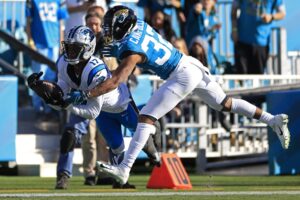Green Bay Packers quarterback Aaron Rodgers continued his dominance over the Chicago Bears on Sunday. Rodgers and the Packers went into Soldier Field and beat the Packers 24-14. The victory improved Rodgers record against the Bears to 21-5. Rodgers play had a lot to do with the Packers victory on Sunday, but he owes his head coach a big thank you. The offensive gameplan head coach Matt LaFleur implemented on Sunday was a thing of beauty.
Sunday’s Win Illustrates How Good of a Play-Caller Matt LaFleur Has Become
Prior to being hired as the Packers head coach, Matt LaFleur spent one season as the Tennessee Titans offensive coordinator. It wasn’t an overly impressive season for the Titans offense. They finished the season as the 27th ranked scoring offense. So, when the Packers hired Matt LaFleur the following season to be their new head coach, some Packers fans weren’t too excited.
But since taking over as the head coach, as well as the offensive play-caller, LaFleur has changed most of those skeptical fans’ minds. Even with not having a prior relationship with Rodgers, they have become one of the top play-caller/quarterback combinations in the league. Under LaFleur’s guidance, Rodgers put up a season that nabbed him his third league MVP trophy in 2020. By no means are we saying that it was LaFleur’s play-calling prowess that got Rodgers that honor. But LaFleur should be given at least some credit for the achievement.
The Matt LaFleur-Aaron Rodgers magic has carried over from the 2020 season. After a very rocky season opener against the New Orleans Saints, the Packers offense has found their groove. The numbers from Sunday’s game might lead some to believe they haven’t, the numbers don’t tell the whole story. The numbers weren’t gaudy, but the offense did what was needed to win the game.
Adjustment After First Series
For NFL fans who like seeing aggressive defenses, they should make sure to watch the Bears defense. Their defense loves to bring pressure. First-year defensive coordinator Sean Desai, a name to remember as a future head coach, utilizes outside linebackers, Robert Quinn and Khalil Mack, to do so. That aggressiveness was on display during the first drive for the Packers offense. The Packers came out on that drive by spreading out, running three to four receiver sets. Rodgers and company didn’t find any success and the series quickly fizzled out.
One of the biggest attributes that make a head coach or play caller good is their ability to adjust. For Matt LaFleur, it is one of the reasons he is one of the top play callers currently in the NFL. From what he witnessed in the first series, he knew he couldn’t have Rodgers do seven-step dropbacks. While the Packers offensive line got back Elgton Jenkins back from injury this week, they were still going to have a tough time slowing down the Bears pass rush.
LaFleur shifted not only to quick three-step dropback passes for Rodgers, but he also leaned on his run game. Running the ball alone is vital for LaFleur’s offense, but it also opens up the passing game via the play-action pass. It also slows down an aggressive pass rush, similar to what the Bears have.
The running back combination of Aaron Jones-A.J. Dillon has become a very vital part of Matt LaFleur’s offense. The Dillon-Jones combination isn’t just a “Thunder and Lightning” situation. Both running backs aren’t afraid of making the tough runs and both are capable receivers. With knowing that, LaFleur dialed up both of their numbers frequently on Sunday against the Bears. Jones led the way with 76 yards on 13 carries while Dillon carried the ball 11 times for 59 yards. Rodgers also chipped in seven carries for 19 yards with one touchdown run.
The Packers ability to gain yards on the ground forced Desai to let up on the pass rush and respect the run. If LaFleur hadn’t adjusted and started to stress the run, the Bears pass rush would have teed off on Rodgers and the result of the game might have been different.
Spreading the Wealth
Rodgers finished the game going 17 of 23 for 195 yards with two touchdown passes and zero interceptions. Those numbers aren’t the same type of numbers Packers fans are accustomed to seeing from Rodgers, but the numbers were enough to secure a victory.
Another important number to come from the victory on Sunday is seven. That number represents the number of different Packers that Rodgers completed a pass to. Of course, Davante Adams led the Packers in receiving with four catches for 89 yards. Being arguably the top wide receiver in the NFL, Adams will always get his expected targets and catches. But leading up to the game, many were wondering when the other pass-catchers would step up and take the burden off of Adams. On Sunday, the game Matt LaFleur called allowed Rodgers to utilize some of the other weapons the Packers offense possesses.
Allen Lazard has been making his presence known by his blocking on the outside leading up to this game. However, he hasn’t had his name called a lot when it comes to the passing game. Against the Bears, he continued to block at a high level on the boundary but also contributed in the passing game. He finished the game with three pass catches for 27 yards with one touchdown reception. It was Lazard’s most productive day as a pass-catcher this season.
With the Bears dialing up the pressure frequently, LaFleur called a lot of bootleg passes. The benefactors to these play calls were the tight end group. Veteran tight end Marcedes Lewis caught two passes for 17 yards. At 37 years of age, Lewis isn’t the same pass catcher he once was while he was a standout with the Jacksonville Jaguars. He is the Packers best blocking tight end, something the Packers have leaned on while he has been a Packer. But in the past couple of games, Lewis has caught some very important passes for the Packers offense. Fellow tight ends Robert Tonyan also caught two passes for 10 yards and second-year tight end/h-back Josiah Deguara caught one pass for four yards.
LaFleur’s adjusted game plan took what the Bears were giving the Packers offense. His ability to adjust on the go shows just how good LaFleur is becoming as an offensive play-caller.
Another Top-Notch Offensive Play-Caller
Former Packer head coach Mike Holmgren has, and deservedly so, been given a lot of credit when it came to his offensive play calling. Under Holmgren’s leadership, former quarterback Brett Favre went on to have a Hall of Fame career. Holmgren learned under the master, Bill Walsh, and then went on to become one of the best play-callers himself.
Along with Holmgren, former head coach and offensive play-caller, Mike McCarthy had success guiding the Packers offense. Many will remember the Packers offensive struggles in his last couple of seasons as the Packers head coach. However, under McCarthy’s guidance, he helped guide the Packers offense for a long stretch of time. Favre put up good seasons under McCarthy and Rodgers became an elite quarterback under his watch.
In his third season running the Packers offense, Matt LaFleur is establishing himself as one of the best play-callers in the NFL. After their victory on Sunday, LaFleur has a regular-season record of 31-7. The biggest reason the Packers have been so successful has a lot to do with LaFleur’s ability to call a game. He is quickly joining Holmgren and McCarthy in the group of elite offensive play-callers in Packers history. The only thing separating him from Holmgren and McCarthy is the lack of Super Bowl victory. If he continues to call games as he did on Sunday, it won’t be long before he achieves what Holmgren and McCarthy did. That being lead the Packers to a Super Bowl victory.
[pickup_prop id=”13703″]
Main Photo:
Embed from Getty Images






